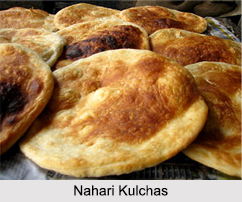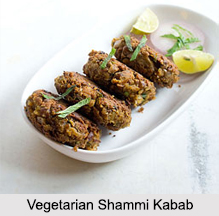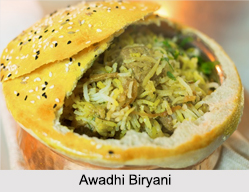 Awadhi Cuisine is known for its dum cooking style. Dishes like kebabs, kormas, biryani, kaliya, nahari-kulchas, zarda, sheermal, roomali rotis and warqi parathas are specialities of this cuisine. The richness of Awadhi cuisine lies in its ingredients like mutton, paneer and rich spices like cardamom and saffron. It is a cuisine native to the Awadh region in Northern India. The cooking patterns of Lucknow are similar to those of Central Asia, the Middle East, and Northern India with the cuisine comprising both vegetarian and non-vegetarian dishes. The Awadh region has been greatly influenced by Mughal cooking techniques, and the cuisine of Lucknow bears similarities to those of Central Asia, Kashmir, Punjab and Hyderabad. The city is also known for its Nawabi foods.
Awadhi Cuisine is known for its dum cooking style. Dishes like kebabs, kormas, biryani, kaliya, nahari-kulchas, zarda, sheermal, roomali rotis and warqi parathas are specialities of this cuisine. The richness of Awadhi cuisine lies in its ingredients like mutton, paneer and rich spices like cardamom and saffron. It is a cuisine native to the Awadh region in Northern India. The cooking patterns of Lucknow are similar to those of Central Asia, the Middle East, and Northern India with the cuisine comprising both vegetarian and non-vegetarian dishes. The Awadh region has been greatly influenced by Mughal cooking techniques, and the cuisine of Lucknow bears similarities to those of Central Asia, Kashmir, Punjab and Hyderabad. The city is also known for its Nawabi foods.
Features of Awadhi Cuisine
Dastarkhwan is a carefully laid-out ceremonial dining spread that is customary in Awadh. The menu changes according to seasons. During winters rich food is consumed. Paye (trotters) is cooked overnight over a slow fire and the shorba (thick gravy) is eaten with naans. Turnips are also cooked overnight with meat koftas and served as an accompaniment during lunch. Birds like partridge and quail are consumed during winter as they are heat giving meats. Fish is relished in this time. River fish is preferred in Awadh. Peas are one of the used vegetable in this region.
The bawarchis (chefs) and rakabdars (gourmet cooks) of Awadh invented the dum style of cooking or the art of cooking over a slow fire, which has become synonymous with Lucknow today. Their spreads consisted of elaborate dishes such as kebabs, kormas, biryanis, kaliyas, nahari-kulchas, zarda, sheermal, rumali rotis, and warqi parathas. The richness of Awadh cuisine lies not only in the variety of cuisine but also in the ingredients used like mutton, paneer, and rich spices, which include cardamom and saffron.
Kebabs are an integral part of Awadhi food. Lucknow is proud of its Kebabs. There are several varieties of popular kebabs in Awadhi cuisinem namely Kakori Kebabs, Galawat ke Kebabs, Shami Kebabs, Boti Kebabs, Patili-ke-Kebabs, Ghutwa Kebabs and Seekh Kebabs are among the known varieties. The kebabs of Awadhi cuisine are distinct from the kebabs of Punjabi cuisine. Awadhi kebabs are grilled on a chula and sometimes in a skillet as opposed to grilling in a tandoor in Punjab. Awadhi kebabs are also called "chula" kebabs whereas the kebabs of Punjab are called "tandoori" kebabs.
Spices of Awadhi Cuisine
An Awadhi chef takes a long time to properly master how to cook dum-style, but it takes even longer to understand how to correctly use spices. There are easily fifty spices used regularly in the cuisine, but in total it is more like 150. The most common are Kebab Chini, Bay Leaf, Asafoetida or Hing, Liquorice, Black Peppercorn, Star Anise, Cinnamon, Clove, Cardamoms i.e. Badi Elaichi, Chotti Elaichi, Kala Jeera or Caraway Seeds, Cumin, Coriander, Chilies and Fenugreek.
Kebabs of Awadhi Cuisine
The kebabs of Awadhi cuisine are distinct as they are grilled on a chula and sometimes in a skillet. The Seekh Kebab is one of the famous kebabs. Kakori kebab and shammi kebab are the most sought after kebabs. Other type of kebabs includes Galawat kebab, Pasanda Kebab, Boti kebab. There are even Vegetarian kebabs that include Dalcha Kebab, Kathal ke Kebab, Arbi ke Kebab, Rajma Galoti Kebab, Zamikand ke Kebab and so on.
Seekh Kebab
The Seekh kebab has long been considered an irresistible piece in the Awadhi dastarkhwan. Introduced by the Mughals it was originally prepared from beef mince on skewers and cooked on charcoal fire. Now lamb mince is preferred for its soft texture.
Tunde Kebab
Tunde kebab is so named because it was the speciality of a one-armed chef. The tunde kebab claims to be unique because of the zealously guarded family secret recipe for the masala (homemade spices), prepared by women in the family. It is said to incorporate 160 spices.
Kakori Kebab
Kakori kebab is considered blessed since it was originally made in the place by the same name in the dargah of Shah Abi Ahder Sahib with divine blessings. The meat used is from the tendon of the leg of mutton, combined with khoya and spices.
 Shami Kebab
Shami Kebab
Shami kebab is made from minced meat, usually with chopped onion, coriander, and green chillies added. The kebabs are round patties filled with spicy mix and tangy raw green mango. The best time to have them is in May, when mangoes are green. When mangoes are not in season, kamrakh or karonda may be substituted for kairi, as both have a tart flavour reminiscent of raw mango.
Galawat Kebab
Galawat Kebab is a variant kebab made without any admixture or binding agents and comprising just the minced meat and the spices.
Nazaqati Boti Kebab
Boti kebabs are prepared during festive season or special occasions to feast on with family and friends. Succulent mutton cubes marinated in myriad of spices and cooked in aromatic saffron, rose petal paste and coconut. Indulge in kebabs and enjoy the festivities.
Korma and Curry of Awadhi Cuisine
Korma is actually the Indian name for the technique of braising meat. It originated in the lavish Moghul cuisine wherein lamb or chicken was braised in velvety, spiced sauces, enriched with ground nuts, cream and butter. While kormas are rich, they are also mild, containing little or no cayenne or chillies. There are both vegetarian (navratan korma) and non-vegetarian (chicken, lamb, beef and fish korma) varieties of korma. Murgh Awadhi Korma is a classic from Lucknow.
Kaliya which is a mutton preparation is another popular non vegetarian item. Another famous dish is Prawn Curry in Awadhi style. The prawns are first cooked in ghee till they are nice and crisp and then in a yogurt-based gravy along with fenugreek seeds and leaves, ginger-garlic paste, red chilli and garam masala. They are best enjoyed with steamed rice. Other popular dishes are Badami Murgh, Murgh Do Pyaaza, Pasanday, Murgh Shahi Korma, Kadhai Murgh, Murg Wajid Ali, Nahari, Narhisi Khofta, Murg Mussalam, Nawabi Chicken, Kundan Kaliya, Magaz Masala, Murg Korma, Murg do pyaza, Zamin Doz etc. Popular veg dishes are Dhingri Shabnam, Gobhi Mussalam, Bharwa Bhindi, Nimena or Nimona, Cholley or Chana Masala etc.
Roti and Parathas of Awadhi Cuisine
Different types of Roti are also well known like rumaali roti, tandoori roti, naan, kulcha, lachha paratha, sheermaal and baqarkhani. Breads made of other grains like Makai ki roti, Jowar ki roti, Bajre ki roti, chawal-ki-Roti are common. Sheermals are a sort of paratha that was invented by mamdoo bawarchi. Popular varieties are Gilafi Kulcha, Taftan, Sheermal, Malida, Bakharkhani, Varqi Paratha, Jalebi Paratha etc.
Rice Preperations in Awadhi Cuisine
Pulao is made by cooking meat in ghee with warm aromatic spices and then layered with meat curry or marinade (depending on the type of biryani), then sealed and cooked over low heat until done. The vegetarian version is called tehri. Popular rice dishes are Shah Hahani Pulao, Degi Biryani, Dum Biryani, Yahkni Pulao etc.
 Desserts of Awadhi Cuisine
Desserts of Awadhi Cuisine
Halwas play an important role in winters. There are several varieties of these such as gram flour, sooji, wheat, nuts and eggs. The special halwa or halwa sohan has four varieties like Papadi, Jauzi, Habshi and Dudhiya. The Jauzi Halwa Sohan is also a hot favorite. Other popular desserts are Almond Kulfi, Almond Seera, Badam Halwa, Boondi Raita, Carrot Halwa, Mango Burfi, Kaddu Ki Kheer, Phirni and many more exotic sweet dishes.
The utensils are peculiar which are required to make dishes like Kebabs. Meat kebabs are generally cooked in a mahi tawa. Bone china plates and dishes were used in Lucknow since the rule of Nawabs. Food habits of Nawabs and a few adjoining parts of Awadh by the royal cooks known as "Bawarchis" are popular. They maintain strict discipline, bordering on religious fervor and still follow the traditional style of cooking, safeguarding the recipe and spices handed down to them by their ancestors.



